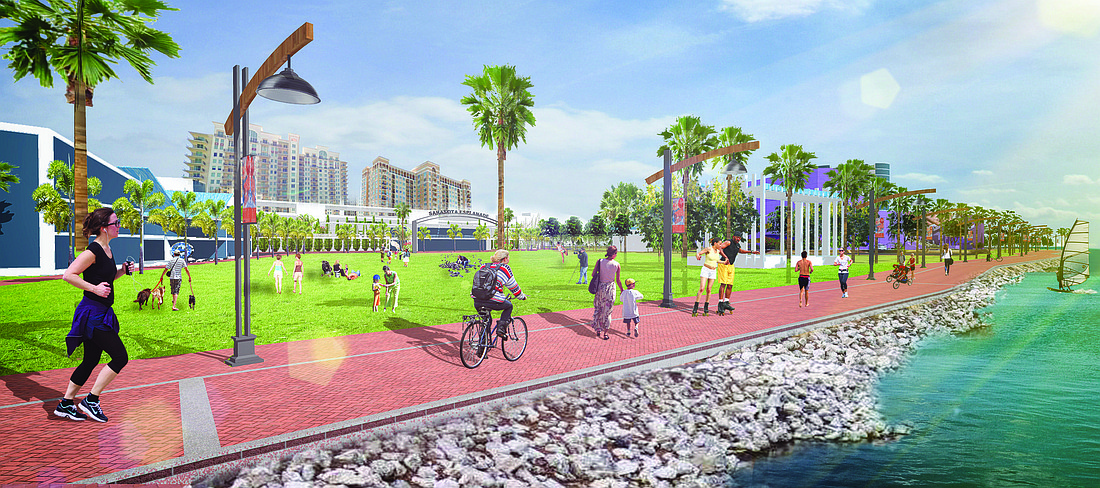- April 22, 2024
-
-
Loading

Loading

As it begins to roll out its proposal for city-owned waterfront land, the people behind Sarasota Bayfront Now want one thing to be clear: They can make that proposal a reality.
The group made its public debut on Friday, outlining its plans at a cocktail reception at The Francis in downtown Sarasota. Those plans include: a $100 million bayfront aquarium, a 60,000-square-foot conference center, an 1,800-vehicle parking garage, a 3-acre public waterfront esplanade and a network of new streets and other infrastructure improvements.
The debut was earlier than the principal players would have liked, precipitated by the leaking of a confidential document that was, for most, the first insight into what would eventually become known as Sarasota Bayfront Now.
That leaked document was turned over to Vice Mayor Susan Chapman, who has questioned why private groups are taking the time to develop plans for public land without working in the open. Sarasota Bayfront Now — composed of venture capital group Seven Holdings, Hoyt Architects, Core Construction and the Arizona-based company Governmental Facility Development Services — is hoping to change the tenor of the conversation surrounding its proposal.
Chris Cogan, a co-managing partner with Seven Holdings, says a fact that distinguishes his group from others is that Sarasota Bayfront Now would see a project through to completion — and quickly.
“We have a team that knows how to do that and get it done, and we have a plan that is feasible, realistic, and can get done now,” Cogan said. “And that’s where the term Sarasota Bayfront Now comes from.”
The contrast is being drawn with Sarasota Bayfront 20:20, a group that is undertaking a city-sanctioned master planning effort for some of the same land. Cogan said both groups are pushing for a bayfront that can help define the city for generations.
“I don’t know anybody who lives in Sarasota who wouldn’t want to embrace the concept that is being put forth for the bayfront,” Cogan said. “This is a potential legacy for Sarasota.”
Steve Nielsen, senior vice president with Governmental Facility Development Services, has an extensive background working on public projects. He spent 24 years as the community development director for Tempe, Ariz., and another decade formulating and implementing a comprehensive development plan for Arizona State University.
In 2012, he formed Government Facility Development Services. The purpose of the company, he said, was to bring projects like the one Sarasota Bayfront Now proposes to fruition. The organization’s goal is to allow for the partially privatized development of public projects so governments don’t bear the financial burden.

Under the group’s proposal, a nonprofit foundation would serve as the borrower taking out bonds to fund the aquarium, meeting center, parking garage and other expenses. A for-profit hotelier would be responsible for bearing the burden of the operating costs of the meeting center, historically a money-losing enterprise for municipalities. By redirecting money generated within the area — including, most likely, tax revenue — Neilsen says the plan is to be self-sustaining, with the potential for expansion.
“We look for synergy — to create revenue, create excitement,” Nielsen said. “We want to drive people into the area, which allows us to fund the remaining cultural arts facilities and the things that are missing that we want.”
Brian Jones, director of development for Core Construction, said he’s most excited about the number of jobs that could be generated if this project is approved. The group estimates its proposal could generate 2,750 construction jobs and 1,300 full-time equivalent employment opportunities.
The group has touted the speed with which it could make the project a reality — if approved later this year, it says it could have an aquarium in place within 30 to 36 months. However, the emphasis on “now” works another way. Considering the economic climate, this project is appealing and feasible now. Should any one element of this intricate plan fall out of line, however, that may no longer be the case.
“We believe the stars have aligned perfectly for this project,” Jones said. “We have an aquarium in need of upgrades, a bayfront park in need of improvement, historically low interest rates and an economy on the rebound. This has created a perfect storm for a project of this type.”
And so, the reception Friday ended with a call to arms: Write city leaders and ask them to accept private proposals for the public land. By mobilizing the public and getting people to endorse a route by which the proposal can become a reality, Sarasota Bayfront Now is hoping it can win over a commission that has, at least in part, shown itself to be skeptical of this plan.
The reaction to the presentation was mostly positive, but attendees did ask why outside groups — such as the Sarasota Bay Estuary Program — had not been involved in the conversation earlier in the process.
Cogan said this was just the first step in the campaign to connect with the public.
“We’re prepared to answer questions and set the record straight,” Cogan said. “It’s a disservice to the community, the misinformation that’s been speculated.”
The people behind Sarasota Bayfront Now repeatedly stressed their belief in the plans. They believe it’s good for the city; they believe it’s practical; they believe that the ability to get something in place on the bayfront should be highly valued. But for the proposal to actually become a reality, they need others to believe in it, too.
“This plan can get done,” Cogan said. “It’s a realistic plan that has a high probability of getting done if people will stop to take a look at it and put their competitive interests aside.”
Contact David Conway at [email protected]